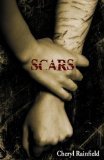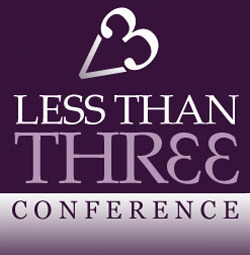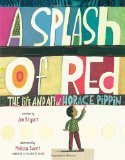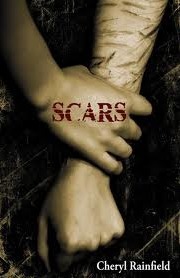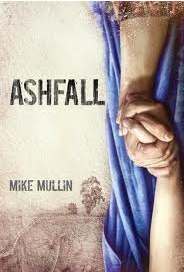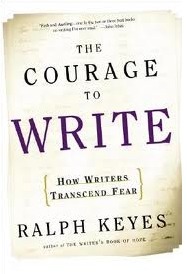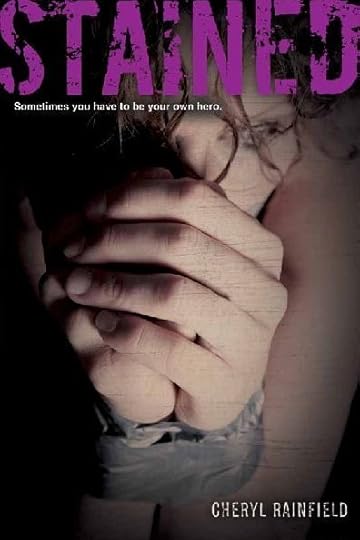Cheryl Rainfield's Blog, page 62
March 24, 2013
Important video: Looks Aren’t Everything; Believe Me, I’m a Model
Our society is obsessed with looks. The “ideal” or image of beauty is pushed on us constantly in the media, and it hurts us (especially women, but also men). It encourages eating disorders; low self esteem; unrealistic expectations of ourselves; and dissatisfaction with our bodies; and it encourages us to judge ourselves and others on how we look on the outside rather than who we really are, how we treat other people and what we say or do, or levels of kindness. And I think that’s really sad. Also frightening.
I think this video is a great reminder that our current society’s perception of beauty is just that–perception. And not a healthy one.
March 3, 2013
Had a fantastic time at Ottawa’s Writers’ Festival with Charles de Lint and Gary Blackwood
I had a wonderful time at the Ottawa Writers’ Festival! I was on a YA book panel “Hiding In Plain Sight” with Charles de Lint and Gary Blackwood. I’ve long loved Charles de Lint’s books, so it was lovely to spend time with him and his partner MaryAnn, and to find I really liked them both as people, and I also really liked Gary Blackwood. Most children’s and YA writers that I’ve met have been lovely people who help other writers.
Neil, the organizer of the Writers’ Festival, was kind enough to pick me up at the train station and drop me off at the hotel, and then pick me and Gary up a few hours later for a meal at Bridgehead Coffee House (an independent coffee house chain in Ottawa selling fair-trade coffee who were one of the sponsors of the festival), and later a quick chat with all three of us writers before our talk.
I so enjoyed talking with Charles de Lint, MaryAnn Haris (his partner), and Gary Blackwood beforehand! It was nice to connect with them–all kind, good people. When we went out for our talk, there was a large crowd! Many people from Ottawa, and some from other regions like Kingston–and even two women who traveled in from Boston to see us! Wow!
I always get anxious, even scared before public speaking–I think part of it is my trauma past (my abusers used to tell me they’d kill me if I talked, so I used to write instead of speak), part of it is that I’m open and honest about my past–it’s part of what I write, and I also want people to know that they’re not alone, part of it is being an introvert, so it can be overwhelming, part of it is being a bit shy, and part of it is perhaps just being a writer and a creative person.
My hands shook early on in the talk–thank goodness we had little mikes at our faces, and I didn’t have to hold one! Though I like talking about my books, so I could talk a bit about each–Scars, Hunted, Stained, and even Parallel Visions. And I grew calmer and felt better, especially with such lovely audience response. I even had people clapping for me after my first introductory mini talk, which surprised me but also felt lovely (especially later when I wasn’t so scared  ), and I also really liked that people in the audience responded verbally to me and to us all. I grew more and more comfortable as it became a real conversation between Neil, the moderator, and Charles and Gary and me. We had some opinions that differed and some opinions that were the same or very similar, but I think we all came from our own experiences and truths, which is especially true as writers. I don’t think there’s one way to write or edit. We all have ways that work best for us.
), and I also really liked that people in the audience responded verbally to me and to us all. I grew more and more comfortable as it became a real conversation between Neil, the moderator, and Charles and Gary and me. We had some opinions that differed and some opinions that were the same or very similar, but I think we all came from our own experiences and truths, which is especially true as writers. I don’t think there’s one way to write or edit. We all have ways that work best for us.

Here the three of us are (from left to right): Gary Blackwood, me, Charles de Lint. MaryAnn Harris, partner to Charles de Lint, took the photo at the end of our panel. And I think there’s more photos to come from other people, too. 
The audience was really responsive and interested in the talk–I could *feel* them listening–and they asked great questions. And then so many of them bought our books and came to get them signed, which I really appreciated. I also enjoyed talking with the readers, hearing the things they had to say and the ways they related–and it was lovely to hear from many of them that they really appreciated the things I’d said and felt I was brave or strong or compassionate.
I already had two of Charles’ books (Under My Skin and The Blue Girl, both of which I highly recommend!) that were on the table for sale by Kaleidoscope Kids Bookstore, but I didn’t have Gary’s, so I bought to read later. I love good YA books! And I was so happy to see Kaleidoscope selling my book Hunted, and they graciously sold some copies of Scars that I brought in (since WestSide Books closed the company, it’s much harder to get copies of Scars).
I was so disappointed to have to miss Charles de Lint’s writing workshop–how I wish I could have sat in for that!–but it was a long train ride home, and I had to get back.
I enjoyed myself so much at the Ottawa Writers’ Festival–especially because of the people. I get very tired after author events, though, so it was nice to come home to my little dog Petal, who was ecstatic to see me (grinning) just as I was to see her. My lovely neighbor who’d been taking care of her said that she’d had a lot of fun with Petal, and she laughed to see Petal leaping so excitedly around because I’d come home. And then she slipped me a bar of dark chocolate! What a sweetheart.  I was so tired I was almost swaying on my feet.
I was so tired I was almost swaying on my feet. 
And then I discovered that Charles de Lint did a post about our panel, and bought Scars! (beaming) That felt so good to hear!
And then I read a post that a pre-published YA author wrote about our panel–and she really enjoyed my talk, mentioned a lot of the things I said in the panel, and is going to read and review Scars! (beaming) That also felt good to read. I hope she likes Scars so much that she also searches out Hunted and Stained and Parallel Visions. I always hope for that with my readers. (smiling) It’s what I do when I love an author’s books–I go out and find a bunch of their others.
It was a lovely, satisfying panel and trip to the Ottawa Writers’ Festival. I’m so glad they did a YA panel this year!
Here’s another pic of me from our panel, from YA Now!
You can see a bunch more of the event via YA Now here.
…I forgot to mention, because I only just opened my suitcase (heh) that they also gave us presenters some lovely swag: a WritersFestival backpack, a hardcover blank journal to write in and a pen (what a nice touch), a seed to plant an evergreen tree (lovely!), and a copy of their Writers Festival Review. What a nice touch!
March 1, 2013
Today Is Self-Injury Awareness Day. I hope you’ll read and share this post.
Today, March 1st, is Self-Injury Awareness Day. I think it’s so important to help get more compassionate information and resources out there about self-harm–not just today, but every day. So many people self-harm in secret, and suffer in great emotional pain, often feeling shame about it.
For me, self-harm was one of the only ways I could survive and keep enduring the abuse I was living with at home–incest and ritual abuse–from a young age. It is also something I was taught by my abuser to keep myself quiet–but that’s not common. What is common is using self-harm to cope with great emotional distress. I used cutting to keep from killing myself, to lessen overwhelming emotional pain, to shut down horrific abuse memories, to silence myself, to punish myself, and many other reasons.
One of the most helpful things for me in stopping self-harming was to learn to love myself, and to realize that I didn’t deserve to be hurt, not even by myself, despite what my abusers had taught me. It was also so important for me to be around safe, kind people who gave me compassion and support and helped me work through some of the abuse. And to find out that I wasn’t alone, that I wasn’t the only one who’d cut to cope. Those things, especially, helped me to stop cutting.
I hope you’ll read and share my Reasons Not To Hurt Yourself. I wrote it with everything I needed to hear and know to help stop cutting.
You might also want to read my novel SCARS. Although it’s fiction, I put a lot of my own experiences into the novel. It’s actually my own arms on the cover. I’ve heard from many, many readers that it helped them feel less alone, or talk to someone for the first time about their self-harm, or get help, or even keep from killing themselves. (Though please also take care when reading it, as, like anything that discusses self-harm in an honest way, it may be triggering and bring up your own emotion.) And I’ve heard from many other readers who haven’t used self-harm or hadn’t known anyone who had, that it helped them understand self-harm more, and judge it less. Both are exactly what I wanted to have happen!
And you may also want to check out my tips on dealing with self-harm: How To Stop Self-Harming, Alternatives To Self-Harm, and Helpful Responses To Someone Who’s Self-Harmed.
There shouldn’t be silence or shame about self-harm. What there should be is compassion.
February 20, 2013
Tickets now available for Less Than Three YA Lit/Anti-Bullying conference! Come see me, Heather Brewer, Ellen Hopkins, A.S. King, Jennifer Brown, Lisa McMann, David Levithan, Carrie Jones, Carrie Ryan, & more!
Tickets are now available for the Less Than Three YA Lit/Anti-Bullying conference! I’ll be speaking there on a panel, along with YA authors Heather Brewer (who will give the keynote address), Ellen Hopkins, A.S. King, Jennifer Brown, Lisa McMann, David Levithan, Carrie Jones, Carrie Ryan, and more! AND four local authors–Jody Feldman, Antony John, Sarah Bromley and Cole Gibson–will be moderating the panels. What a fantastic group of YA authors, eh? 
We’ll be talking about bullying (which many of us personally experienced), YA lit and bullying, anti-LGBT bullying. We haven’t finalized the topics yet, but they’ll all be about bullying. I was bullied a lot as a child and teen, as well as being an abuse survivor. It’s something I care about!
Tickets are only $10, and will include all four panels, keynote speech, autograph session, and a social hour with the authors. You’ll also get a tote bag with some goodies focused on bullying. I think this will be an important conference. I hope you’ll join us. Tickets are limited, so if you’re thinking about going, you might want to sign up soon.
Our conference–which the wonderful Heather Brewer started and organized–has been mentioned in Publishers Weekly, Saint Louis’ Riverfront Times, and Heather Brewer was just interviewed by The New York Times, as well. I’m looking forward to this!
February 18, 2013
Two great and different picture books that encourage a love of art: Andrew Drew and Drew, and A Splash of Red
I love art–creating it and looking at it. Two recent picture books will encourage a love of creating and appreciating art in readers–Andrew Drew and Drew and A Splash of Red: The Life and Art of Horace Pippin
and A Splash of Red: The Life and Art of Horace Pippin . The first is more playful and fun, encouraging readers to doodle and draw and have fun with art, the second is more serious and thoughtful, helping readers know that anyone can create meaningful, moving art, even without training or much equipment. Both are books that encourage a love of art and creativity, and will inspire many readers.
. The first is more playful and fun, encouraging readers to doodle and draw and have fun with art, the second is more serious and thoughtful, helping readers know that anyone can create meaningful, moving art, even without training or much equipment. Both are books that encourage a love of art and creativity, and will inspire many readers.
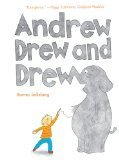

Andrew Drew and Drew
Written and illustrated by Barney Saltzberg
Published Oct 2012 by Abrams Appleseed
ISBN-10: 1419703773
ISBN-13: 978-1419703775
Age Range: 3 – 6 years
Source: I purchased it myself
My rating: 5 out of 5 stars
In Andrew Drew and Drew , Andrew loves to doodle. He begins with nothing but a line, and ends up with fantastical creatures and things he both imagines and sees. The book is a delight to read. What really makes this book work is the combination of simple, vibrant drawings, and the innovative way they are laid out.
, Andrew loves to doodle. He begins with nothing but a line, and ends up with fantastical creatures and things he both imagines and sees. The book is a delight to read. What really makes this book work is the combination of simple, vibrant drawings, and the innovative way they are laid out.
The book has flaps that cover parts of the drawings, and flaps that you unfold to see entire drawings, which allow the reader to see what Andrew’s doodles began with, and then start to turn into, and then end up as–each of them different than you’d expect, and each of them making up the whole. This brings a feeling of magic and freshness to the book, and will delight child and adult readers alike. For instance, what starts out looking like a set of stairs, and then Andrew hanging off the stairs to get to the ground, turns into a dragon with scales on his back–all without changing the original part of the drawing. Kids will want to quickly turn the flaps again and again to see what the simple lines become. Andrew Drew and Drew reminds me of one of my favorite books, Harold and the Purple Crayon, while still retaining its own voice and magic.
The text is simple and clean, all about the magic and possibilities of drawing. The text and the illustrations work beautifully together. This book made me want to draw, and I had so much fun seeing what Andrew’s drawings were turning into. I think this book will delight any reader, and encourage an interest in creating doodles or drawings, without feeling like the drawings have to be perfect (so taking the pressure away, and making art fun). Saltzberg did an amazing job with this book; it’s one of my new favorites. I highly recommend it.
A Splash of Red: The Life and Art of Horace Pippin
Written by Jen Bryant, illustrated by Melissa Sweet
Published January 2013 by Alfred A Knopf Books For Young Readers (Random House)
ISBN-10: 0375867120
ISBN-13: 978-0375867125
Age Range: 5 – 8 years
Source: Review copy provided by the publisher in exchange for an honest review
My rating: 4 out of 5 stars
A Splash of Red: The Life and Art of Horace Pippin tells the story of artist Horace Pippin and some of the hardships he endured–being poor and not having the money for art supplies or art training, being Black in a racist society (though this is only hinted at with the mention of his grandmother being a slave), going to war and seeing horrible things happen, injuring his arm that he used for art–and yet how he still found a way to make art that moved people and that was recognized by other people in the art world.
tells the story of artist Horace Pippin and some of the hardships he endured–being poor and not having the money for art supplies or art training, being Black in a racist society (though this is only hinted at with the mention of his grandmother being a slave), going to war and seeing horrible things happen, injuring his arm that he used for art–and yet how he still found a way to make art that moved people and that was recognized by other people in the art world.
Bryant makes Horace Pippin’s life story interesting to readers, showing us regular, everyday things from Horace’s life–being poor, jobs he did to help his family, the way he loved to draw with charcoal and the way drawing made him happy. She makes readers care about Pippin. I love how Bryant showed that Horace Pippin used art to help him cope with and heal from traumatic events–the war. Art (and writing) can be powerful outlets to help with trauma, and at the same time powerful ways to communicate with others. I also love that Bryant shows us how Horace Pippin created art that people were moved by and admired, even though he didn’t have enough money for art supplies, was completely self-taught, and didn’t create his first oil painting until he was forty. Horace Pippin went from hanging his art in shoe-store and restaurant windows to real art galleries and museums, finally gaining success. At times I wanted a little less information in the text, especially in the early years, but most was very interesting and created a good picture of the artist and his life.
Bryant includes a historical note at the back of the book telling us more about Horace Pippin, as well as providing a resource guide at the back of the book.
Sweet’s art–done in watercolor, gouache, and mixed media–draws the reader in, moving from farther out views, such as Horace outside his house with a horse and carriage, to closer where we see Horace sitting on the floor drawing charcoal. This movement in perspective helps create visual interest, and so do the varying sizes and shapes of the illustrations, with full spreads on some pages, rounded illustrations on others, borders on some, and what looks like the use of paper in many. Sweet brings elements from the text on the page, weaving them together, such as wood that Horace had gathered sitting beside him while we see him draw his charcoal drawings. I love the layers in the illustrations–like when we see silhouettes of Horace, some classmates, and his teacher through a school window and the brick around it, and then below and partially overlapping it and the text, we see Horace’s spelling lists where he draws pictures beside the words. I also love how quotes from Horace Pippin are interspersed throughout the artwork in various colors and styles, all hand drawn. The quotes add to the story and help us understand Horace Pippin more. I especially love (and identify with) “If a man knows nothing but hard times, he will paint them, for he must be true to himself…”
A Splash of Red is a moving reminder that all of us who want to create art or follow our dreams can, and that what matters is the desire and determination to create it. It also lets readers know that even if they don’t have art training or the right art supplies, they can still create art and it can reach a wide audience; they just have to not give up. Recommended!
February 1, 2013
Guest Post: Writing With Courage by YA author Mike Mullin
 I’m happy to have Mike Mullin here today, talking about writing with courage. I love his post, and I’m honored by what he wrote. I believe Mike Mullin already has lots of writerly courage, and it’s something I like and respect. I think it can help make deeper stories. Take it away, Mike!
I’m happy to have Mike Mullin here today, talking about writing with courage. I love his post, and I’m honored by what he wrote. I believe Mike Mullin already has lots of writerly courage, and it’s something I like and respect. I think it can help make deeper stories. Take it away, Mike!
Writing with Courage
When Cheryl invited me to be a guest poster on her blog, I knew immediately what I wanted to write about: courage. You see, I’ve been admiring Cheryl’s writing from afar for almost two years—since I first read Scars. And while there may be a few better prose stylists or a few better plotters working in young adult literature, there is no-one writing with more raw power—with more courage—than Cheryl.
Re-reading the paragraph above, I realize that “admire” is the wrong word for how I feel about Cheryl’s writing. Insanely envious is more like it. Seriously, when we finally meet, I’m going to steal a strand of hair from her to use in a voodoo ritual—your juju will be mine, Rainfield!
Courage, particularly in writing, is rare, precious, and essential. I certainly don’t have it in the generous measure Cheryl does. For over a year, I’ve been trying to write a blog post—yes, a mere blog post—about my own childhood brush with sexual abuse, and I’ve found I can’t. My experience was, thankfully, far less traumatic than Cheryl’s, but I still believe there are lessons we could take from what happened to me, if I ever found the courage to share it.
I was a voracious reader, but in fifth grade I had read absolutely nothing about pedophilia. While the subject is fairly well-covered in today’s young adult literature, it was then and is today—to the best of my knowledge—nearly nonexistent in middle-grade novels. Yet children are more likely to be abused as middle graders than as teenagers. I believe if I had read more about it—if our middle-grade literature had been darker—I might have been better prepared for what happened to me.
That’s not to say that I’m completely devoid of writerly courage. Achieving any measure of success as an author requires it. But I tend to mask the parts of my novels that cut closest to the bone in fictionalized flesh.
For example, I’m occasionally asked what my favorite part of ASHFALL is. (ASHFALL, my debut novel, is about a teen struggling to survive and find his family after the Yellowstone supervolcano erupts, plunging the world into a cataclysmic natural disaster.) I always answer that the scene in chapters 37 and 38 is my favorite. It was never part of any outline; I wrote it spontaneously while I was visiting my Uncle Chuck, who was dying of stage 4 colon cancer. The most difficult part of that visit wasn’t watching my Uncle Chuck die—we’d known he was going to die for some time—it was seeing his wife and children showering love upon him, even while they were trying, and failing, to hide their own grief.
In chapters 37 and 38 my protagonists, Alex and Darla, meet a woman who’s just lost her husband. She’s pulling three young children behind her on a toboggan, and one of them, Katie, is desperately ill. Alex wants to stop and try to help. Darla, who is far more practical than Alex, argues that they should go on—that they can’t help everyone who’s suffering. Alex wins the ensuing argument. They stop and try to help, but Katie dies anyway. I think the power of that scene flows from the fact that I chose to pour what I was feeling into it—despite the pain that writing it caused me. That, perhaps, is also a form of courage.
I believe writerly courage can be developed like any other aspect of writing. One of the reasons ASHFALL broke through and got published, while my earlier manuscripts did not, is that ASHFALL—despite its post-apocalyptic setting—is at its heart a personal story, a coming-of-age story based in my own teenage years. I credit one book in particular for helping me write closer to my own bones, Ralph Keyes’s Courage to Write. His numerous examples—particularly his stories of other writers’ struggles to find courage—inspired me to dig a little deeper and put a little more of myself on the page. If you’re an aspiring author, I highly recommend it. Perhaps I’ll re-read it soon, searching for inspiration to finally begin that blog post.
I knew I had something good in Chapters 37 and 38 of ASHFALL when my wife read them. We were on our way to an education conference in Pittsburg, and she was reading the manuscript out loud while I drove. (That’s a fabulous revision technique, by the way. By listening to your prose, you pick up errors that your eye will skip over while reading.) I heard a catch in her voice and glanced at the passenger seat. Tears were streaming down her face, shining in the mid-morning sun. I thought, yes! I’m a great writer and a terrible husband!
What about you? What inspires you to write courageously? Let me know in the comments, please.
Thank you so much for that thoughtful post, Mike! I think you have a lot of writerly courage–you wrote about grief and pain that you’ve seen and experienced. You dug deep.
People, you can find out more about Mike and his books here:
About Mike Mullin
Mike Mullin’s first job was scraping the gum off the undersides of desks at his high school. From there, things went steadily downhill. He almost got fired by the owner of a bookstore due to his poor taste in earrings. He worked at a place that showed slides of poopy diapers during lunch (it did cut down on the cafeteria budget). The hazing process at the next company included eating live termites raised by the resident entomologist, so that didn’t last long either. For a while Mike juggled bottles at a wine shop, sometimes to disastrous effect. Oh, and then there was the job where swarms of wasps occasionally tried to chase him off ladders. So he’s really glad this writing thing seems to be working out.
Mike holds a black belt in Songahm Taekwondo. He lives in Indianapolis with his wife and her three cats. Ashen Winter is his second novel. His debut, Ashfall, was named one of the top five young adult novels of 2011 by National Public Radio, a Best Teen Book of 2011 by Kirkus Reviews, and a New Voices selection by the American Booksellers Association.
About ASHEN WINTER
It’s been over six months since the eruption of the Yellowstone supervolcano. Alex and Darla have been staying with Alex’s relatives, trying to cope with the new reality of the primitive world so vividly portrayed in Ashfall, the first book in this trilogy. It’s also been six months of waiting for Alex’s parents to return from Iowa. Alex and Darla decide they can wait no longer and must retrace their journey into Iowa to find and bring back Alex’s parents to the tenuous safety of Illinois. But the landscape they cross is even more perilous than before, with life-and-death battles for food and power between the remaining communities. When the unthinkable happens, Alex must find new reserves of strength and determination to survive.
Read an Excerpt
The first two chapters are available on my website: www.ashenwinter.com. You may reprint the first two chapters in whole or in part on your website so long as you do not charge anyone anything to access them.
Find Mike On:
Website
Blog
Google+
Twitter
Facebook
Goodreads
Pinterest
Purchase Links:
Autographed Copies
Indiebound
Amazon
Barnes & Noble
The Book Depository
January 29, 2013
STAINED Cover Reveal and book trailer (YA suspense)
I’ve been waiting for this day for a while–the official cover reveal of STAINED (which comes out this November from Houghton Mifflin Harcourt)! All across the web today, you’ll see many book bloggers, librarians, reviewers, and some readers who have generously taken part in this reveal.
So, here it is–the cover of STAINED!
I really, really love this cover. I think it immediately tells the reader exactly what the book is about, just like SCARS does. You know just from looking at the cover that the girl has been abducted. And if you read the tagline–Sometimes you have to be your own hero–you also know that Sarah has to be the one to rescue herself, and from that you know that she’s a strong-girl character. You don’t see all of Sarah’s face on the cover because she usually hides her port wine stain beneath her hair (she has body image issues, like many of us do). I love that my editor, Karen Grove, and Houghton Mifflin Harcourt asked for what I wanted, and listened! That’s such a good feeling.
So what’s STAINED about?
Here’s the official book description, which I love:
In this heart-wrenching and suspenseful teen thriller, sixteen-year-old Sarah Meadows longs for “normal.” Born with a port-wine stain covering half her face, all her life she’s been plagued by stares, giggles, bullying, and disgust. But when she’s abducted on the way home from school, Sarah is forced to uncover the courage she never knew she had, become a hero rather than a victim, and learn to look beyond her face to find the beauty and strength she has inside. It’s that—or succumb to a killer.
Like I did with SCARS and HUNTED, I drew on some of my own experiences of bullying, abuse, and trauma to write STAINED and to give it greater emotional depth. Like Sarah in STAINED, I experienced abduction, imprisonment, periods of forced starvation, mind control, and having my life threatened. And like Sarah, I tried hard to fight against my abuser, keep my own sense of self, and escape. I hope, if you read STAINED, you will see Sarah’s strength and courage, and appreciate her emotional growth as she reclaims herself.
And here’s the book trailer for STAINED; I hope you’ll watch it!
So, what do you think? Do you like the cover? Does STAINED sound interesting to you?
STAINED comes out Nov 19, 2013. If you want to make sure you don’t miss it, you can pre-order a copy:
Amazon.com (hardcover)
Amazon.com (kindle)
Amazon.ca (hardcover)
Amazon.ca (ebook)
Amazon.co.uk (hardcover)
Amazon.co.uk (ebook)
The Book Depository (free shipping worldwide)
January 25, 2013
Insecurity and the Fiction Writer
“My books aren’t good enough.” “My writing is crap.” “I’ll never…”

I’ve thought those kinds of thoughts many times over the years about my writing–before I was published, and even after. I have always struggled with worrying that my writing isn’t good enough, powerful enough, polished enough. Part of that is being a survivor of abuse, having my abusers intentionally go at my self-confidence. But in talking to other writers, I’ve found that part of it is just about being a writer and a creative, sensitive person in our society.
There’s a lot of rejection and criticism involved in the writing business, which I think can increase or at least reinforce insecurity and doubt–and there’s also a lot of vulnerability. As writers, we our baring our soul on the page. We are showing so much of ourselves, and the deeper and more fully we show ourselves–which I believe makes a more powerful book–the more vulnerable and insecure we may feel when others read and react to our work.
Before we first get published, we can receive hundreds upon hundreds of rejections for years before getting that elusive “yes” and a contract. And it can start to wear at our self-confidence; we may worry that our writing isn’t good enough. It’s painful to get rejections over and over again, and it can feel like publishers or agents are saying that not only is our writing not good enough, but that we, as people, aren’t–because there’s so much of us in our writing.
And that’s really hard. We work so hard at our craft, and yet the quality of a novel is so subjective; it’s based on the opinion and life experiences of the reader or editor, and everything that makes that reader respond or react the way they do. It’s not the same as, say, turning out a finished product in a factory, where most people will agree on whether it’s finished or not, its beauty or lack of. Writing technique is important, and polished writing is important, but we all aren’t always going to agree on what is beautiful, moving writing and what is not. So we face repeated rejections as a writer, and that can feed our feelings of insecurity or doubt or not being good enough at our craft. And it takes time to hone our craft. So we work at it, and we improve. And if we’re lucky, we have someone around us remind us that a rejection letter doesn’t necessarily mean that our work isn’t good enough to be published; sometimes it’s just that we haven’t gotten the right fit yet with the right editor or agent at the right time. But it still feels like a rejection–of our work. Of us.
And writers are often very sensitive people, and many also struggle with depression or self doubt or other things that make the repeated rejection even harder. But if writing is part of the fire that makes us feel alive, we keep writing and submitting.
Even after we get a book published, there’s rejection and criticism through reviews of our book. If we put a lot of our heart and soul into our writing, it can be incredibly painful and feel very personal when someone says they don’t like some aspect of our book or the book at all (though sometimes there’s something we can learn from that and take into our future work). I know some writers who don’t read their reviews at all because of how it can affect them. I know that I usually get many, many glowing reviews for my books, but that just one negative review stays with me, cutting into my mind and heart like barbed wire, making me doubt my writing, my talent, my worth as a writer, and it takes a lot of effort for me to get distance–something I am still trying to learn.
And once we’ve got a book contract, before the book comes out into the world, publishers ask us to seek out blurbs–recommendations of that book–from other, more established and well-known authors. Some authors will never respond, some will refuse (which feels like a rejection), and some will be willing to read but not find the book fits for them, while others will like our work and lend their recommendation. But that whole process involves yet more rejection and can feed into our insecurity.
There also seems to be a natural stage that many writers go through in their writing and repeatedly editing a manuscript where we go into doubt and worry that our writing is crap. Maybe when we’ve become too close to the writing, maybe when we’ve gone over it too many times–but many writers seem to go there. For me, that’s a sign that I’m finished editing the manuscript, at least for the moment, and need to put it away for a while or submit it. It’s helped to learn that over many books, and to be able to see it, remind myself of that stage. But I still go to that place: my writing is crap.
And the rejection or possibility for more self-doubt doesn’t stop there. Even after we have a book or books published, it doesn’t mean we automatically get the next one published. We may receive rejections from publishers or editors still. Or we may lose a trusted editor, may have our publisher fold or be absorbed into another publishing house–changes that again can rock our confidence. Or we may not sell as many books as our publisher wants us to, or as we want ourselves to.
It can be hard not to compare ourselves to other writers who we see as doing better than us with their books, or to see the things that other writers do better than us. And yet it’s so important to be able to recognize our own strengths. I know I write with strong emotion and being inside the character well. I write with passion, I write with tension and fear that make great suspense, and I write about the things I care about, the things that move me, the things that I need to speak about. Those are all important to me. I also know that I have to go through my manuscripts every time and look for more ways to ground the characters in their surroundings and settings, add in more body language, more of all the senses, and layer in symbols. But that’s okay; that’s what we do as writers. We go in through our edits and we round out our characters and story worlds to make them the best that we can make them.
Before I was published, I thought that once I had books published the insecurity would fade, that I would feel more confident. And in some ways it has. I know that I’m a Writer, and that I’m making a living through my books; it’s something I’m proud of and feel good about. But even after having five books traditionally published and one self-published, even after several awards and many glowing reviews, I still struggle with insecurity and doubt about my writing. I still worry that it’s not good enough, and I’m still always trying to make it better. I think that last part is actually useful–the trying to always learn more about the writing craft and make our writing more powerful. But the insecurity and doubt is not useful, and can get in the way.
I’m editing a manuscript of mine right now that I deeply care about, and that in some ways exposes me even more than my other books have (and I always put so much of myself into my work). This has me feeling even more vulnerable and insecure about my writing than usual. I’ve been working from a critique of the manuscript from a fellow writer. I trust this writer, but the first three pages of her feedback are all about the things she doesn’t like and that don’t work for her. It is so much harder to work from the negative first (at least for me), and for me it increases my insecurity and starts those old negative messages running through my head. I found myself jumping at her suggestions, thinking I had to do everything she said in the way she said, even though some of it felt wrong for me and for the story I was trying to tell as I worked. There’s a lot right that she said, but some things just don’t fit for me, and I started feeling a bit stuck. So I had to take a step back and remind myself of the same thing I’ve always told other writers when I critique their work: “My feedback is my opinion, it’s subjective. Take what works for you, and ignore the rest.” Once I did that, the writing/editing flowed for me again, though I’m still battling insecurity and doubt.
What I’ve needed to re-remember is to trust my gut in my writing. I know I need to edit and polish my writing; I want it to be the strongest, the most powerful it can be. I want it to move readers, to touch them, to make them feel for and side with and understand my main character and the problems she’s going through. I want to make a good enough living at my writing. And I want to always, always make a positive difference in the world through my books, even as they entertain. But I also have to remember that I am already doing that. I still get reader letters every week telling me how much Scars moved them, or helped them. And that’s something I need to hold on to. Not the doubt or insecurity or negative messages from the past.
I don’t write half-heartedly. I throw myself into my writing, I draw on my emotion and trauma to write, I make myself the character as I write. I pull up what I know and what I care about and weave it into the story. I always edit and re-edit until it sounds and feels right to me. So I have to trust myself. Know that I am speaking my voice through my writing, and am being heard and responded to. Know that I am putting my heart and soul into my writing. Know that I am doing what I can to make positive change into the world, while telling as good and as moving a story as I can.
So. I am going to try to trust in myself and my writing, and the many people that have told me my writing moves them–and I hope you will, too. Trust yourself, trust your writing, and believe in yourself as much as you can.
January 19, 2013
Another video review of Parallel Visions, this one from reader Kat Wells
Wow! Just got another video review of Parallel Visions, this one from reader Kat Wells! It’s also really articulate and sweet and thoughtful.  I love it! (beaming)
I love it! (beaming)
Video Book Review of Parallel Visions by Reader Jacob Lasher
I absolutely love this video book review that reader Jacob Lasher (who also writes) did of Parallel Visions! (beaming) It’s thoughtful, sweet, and at times funny. You can tell he’s really thought about the writing and about what works for him in a book. It made me feel so good to watch.
BTW, Parallel Visions is still $0.99 for Kindle, Nook, and Kobo until some time tomorrow.

